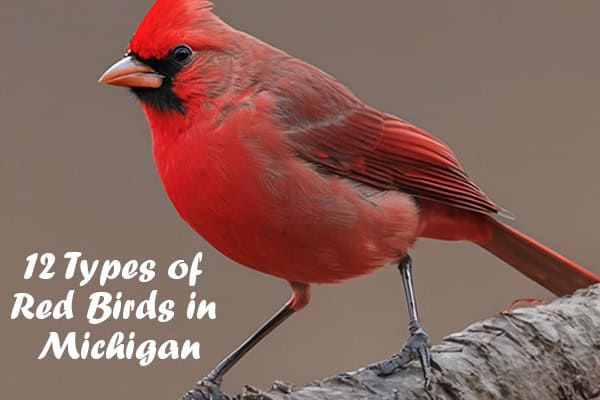Have you ever wondered about those flashes of red birds you see flitting around your backyard or local park in Michigan? Well, you’re in for a treat! Michigan is home to various stunning red birds, from the tiny hummingbirds to the striking cardinals. Let’s dive into the world of these colorful creatures and learn how to spot them.
1. Northern Cardinal
Let’s start with the superstar of red birds in Michigan – the Northern Cardinal. These bright red birds in Michigan are hard to miss with their vibrant plumage and distinctive crest.
- Appearance: Males are bright red all over, while females are more brownish with red accents.
- Size: About 8-9 inches long.
- When to spot: Year-round residents, including red birds in Michigan in winter.
2. House Finch
Next up, we have the House Finch. These little red birds in Michigan are common visitors to backyard feeders.
- Appearance: Males have a red head, breast, and rump, while females are grayish-brown.
- Size: About 5-6 inches long.
- When to spot: Year-round, but more common in urban and suburban areas.
3. Purple Finch
Don’t let the name fool you – Purple Finches are more raspberry red than purple!
- Appearance: Males have a rosy-red color on their head and breast, while females are brown with streaks.
- Size: About 6 inches long.
- When to spot: More common in winter and during migration.
4. Scarlet Tanager
Now, if you want to see a bird that’s truly all red, look no further than the Scarlet Tanager.
- Appearance: Males are bright red with black wings and tail. Females are olive-green.
- Size: About 7 inches long.
- When to spot: Summer breeding season.
5. Summer Tanager
The Summer Tanager is another of the all red birds in Michigan, but with a twist.
- Appearance: Males are entirely red, including their wings. Females are yellow.
- Size: About 7 inches long.
- When to spot: Late spring and summer.
6. Red-winged Blackbird
Here’s one for those looking for black and red birds in Michigan.
- Appearance: Males are black with red and yellow shoulder patches. Females are brown and streaked.
- Size: About 7-9 inches long.
- When to spot: Year-round, but more visible in spring and summer.
7. Ruby-throated Hummingbird
For those interested in tiny red birds in Michigan, meet the Ruby-throated Hummingbird.
- Appearance: Males have a bright red throat, while both sexes have green backs and white bellies.
- Size: About 3-4 inches long.
- When to spot: Late spring through early fall.
8. Red Crossbill
The Red Crossbill is one of the more unusual red birds you might spot.
- Appearance: Males are brick-red, females are yellowish. Both have crossed bill tips.
- Size: About 6-7 inches long.
- When to spot: Irregular visitors, more common in winter.
9. Pine Grosbeak
Another of the red birds in Michigan in winter, the Pine Grosbeak is a treat to see.
- Appearance: Males are rosy-red, females are gray with hints of red or yellow.
- Size: About 8-10 inches long.
- When to spot: Winter visitor, especially in years with good cone crops.
10. Common Redpoll
These small red birds in Michigan are charming winter visitors.
- Appearance: Both sexes have red foreheads, males also have pink breasts.
- Size: About 5 inches long.
- When to spot: Winter, especially during irruption years.
11. Red-headed Woodpecker
For those looking for black, white, and red birds in Michigan, check out the Red-headed Woodpecker.
- Appearance: Bright red head, black back, and white belly.
- Size: About 9 inches long.
- When to spot: Year-round in some areas, more common in summer.
12. American Robin
Last but not least, let’s not forget our friendly neighborhood robin!
- Appearance: Gray-brown back with a reddish-orange breast.
- Size: About 10 inches long.
- When to spot: Year-round, but more visible in spring and summer.
And there you have it, folks! Twelve amazing red birds you can spot right here in Michigan. Whether you’re looking for bright red birds, tiny red birds, or even black and red birds, Michigan’s got you covered. So grab your binoculars and head outside – you never know what colorful characters you might meet!
Remember, patience is key in bird watching. And if you’re having trouble spotting these feathered friends, try setting up a bird feeder. You might just turn your backyard into a red bird hotspot!
data.txt
